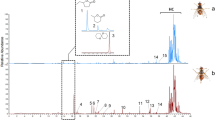Abstract
An interpretation is given of a number of observations on the chemiotropic behavior ofBactrocera oleae in connection with olive maceration water and the fly's return to the olive groves after the first summer rains. To this end, the headspace of both maceration water and leaf leaching water, simulating rainfall, were examined. In both cases, the presence of ammonia, which is generally known to attract fruit flies (Diptera, Tephritidae), was detected and, for the first time, in addition to other compounds that are inert for the fly, the presence of styrene was also detected. This aromatic hydrocarbon was found to be a strong attractant. It is shown that both ammonia and styrene are products of the metabolism of microbial flora present on the olive and leaf surface.
Similar content being viewed by others
References
Bateman, M. A., andMorton, T. C., 1981. The importance of ammonia in proteinaceous attractants for fruit flies.Aust. J. Agric. Res. 32:883–903.
Duncan, D. B. 1955. Multiple range and multiple F tests.Biometrics 11:1–42.
Ercolani, G. L. 1991. Distribution of epiphytic bacteria on olive leaves and influence of leaf age and sampling time.Microb. Ecol. 21:35–51.
Girolami, V., Strapazzon, A., andDe Gerloni, P. F. 1982. Insect-plant relationship in olive flies: General aspects and new findings, pp. 258–267,in R. Cavalloro (ed.). Fruit Flies of Economic Importance. Proceedings in the CEC/IOBC International Symposium, Athens, Balkema, Rotterdam.
Lo Scalzo, R., Scarpati, M. L., Verzegnassi, B., andVita, G. 1994.Olea europaea chemicals repellent toDacus oleae females.J. Chem. Ecol. 20:1813–1823.
Manitto, P. 1991. Biosynthesis of Natural Products, Ellis Horwood, Chichester, U.K. pp. 393–395.
Metcalf, R. L. 1990. Chemical ecology of Dacinae fruit flies (Diptera: Tephritidae).Ann. Entomol. Soc. Am. 83:1017–1030.
Richardson, D. H. S., andDowding, P. 1988. The processes involved in the leaching of leaves under non-polluted conditions and the influence of leachates on leaf-surface micro-organisms, pp. 133–148,in Report of C.E.E. Congress on Scientific Basis of Forest Decline Symptomatology, Edinburgh, March.
Scarpati, M. L., Lo Scalzo, R., andVita, G. 1993.Olea europaea L. volatiles attractive and repellent to the olive fruit fly (Dacus oleae, Gmelin).J. Chem. Ecol. 19:881–891.
Vita, G., andCirio, U. 1980. Fruit fly control by chemical attractants and repellents.Boll. Lab. Entomol. Agric. 37:127–139.
Author information
Authors and Affiliations
Rights and permissions
About this article
Cite this article
Scarpati, M.L., Scalzo, R.L., Vita, G. et al. Chemiotropic behavior of female olive fly (Bactrocera oleae GMEL.) onOlea europaea L. J Chem Ecol 22, 1027–1036 (1996). https://doi.org/10.1007/BF02029952
Received:
Accepted:
Issue Date:
DOI: https://doi.org/10.1007/BF02029952




